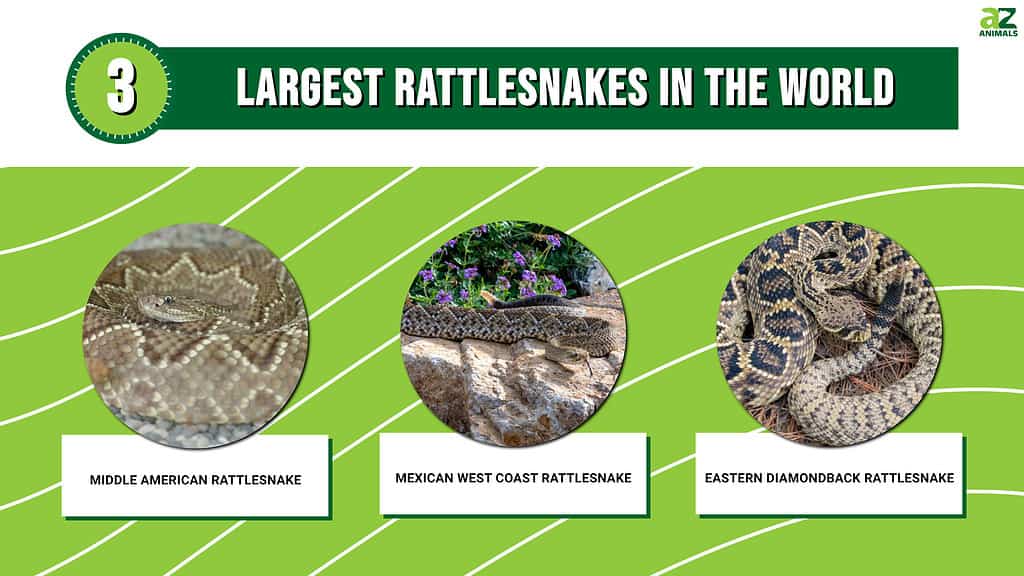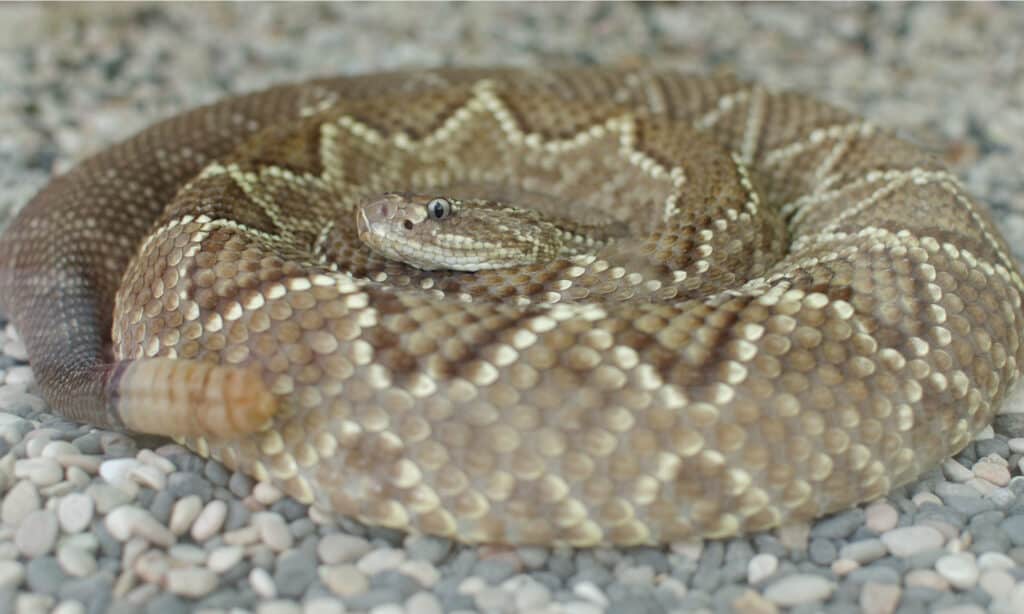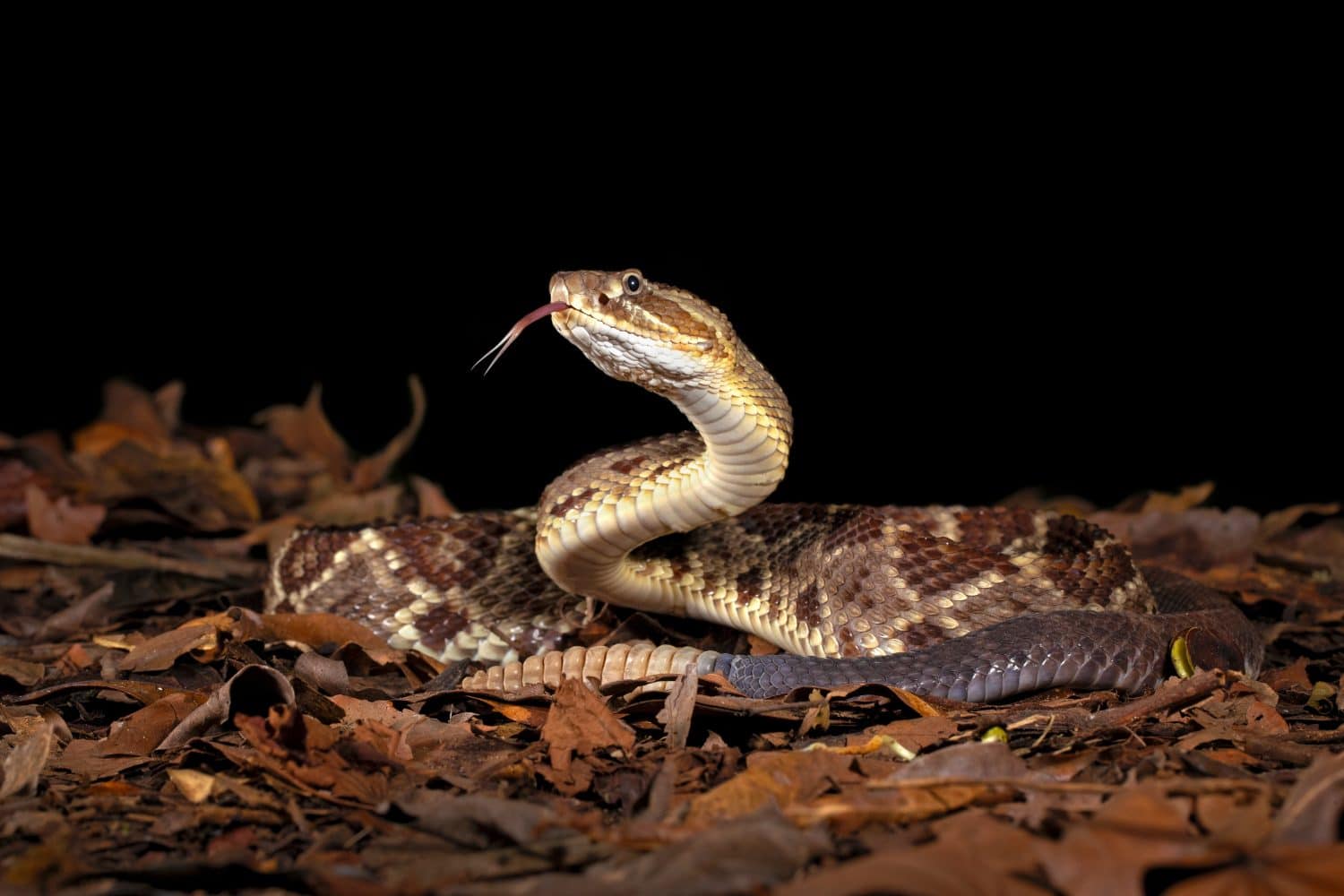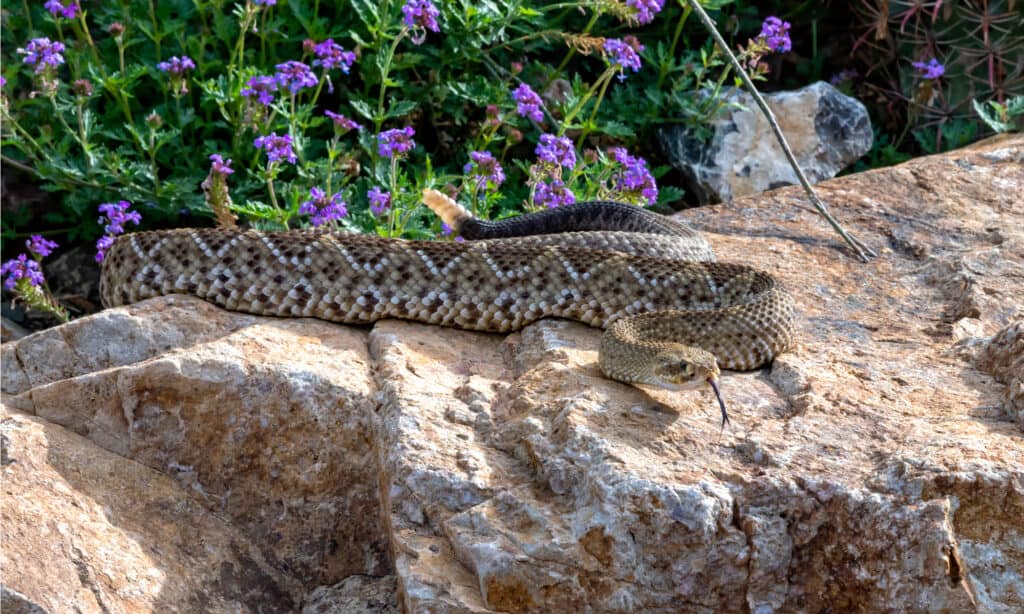Members of the viper subfamily Crotalinae, often known as rattlesnakes, pit vipers, crotaline snakes, or pit adders, are found in the Americas, Asia, and Southeast Asia. At last count, there are about 60 species and probably close to that in subspecies. The rattling at the end of their tails is what gives them this name. When threatened, the rattle serves as a warning. The sound comes from a set of loosely interlocking segments comprised of keratin — just like fingernails. All the snake has to do is wiggle its tail to make them bang against each other.
If you are a threat to them, make no mistake; they will strike! Also, they are all venomous. Many of these rattlesnake species are between 2 and 5 feet long. There are, however, a few beasts that transcend these lengths and are longer than a human being! This article will uncover the three largest rattlesnakes in the world!

Middle American Rattlesnake (Crotalus simus)

The Middle American rattlesnake, or Crotalus simus, can grow up to 6 feet in length.
©edography/Shutterstock.com
Location and Size
Central America and Mexico are home to the Crotalus simus, or Middle American rattlesnake. From central Mexico to Costa Rica, they can be found in open, grassy places as well as low-lying thorny plants. Males tend to grow larger than females, reaching lengths of 51 inches or more in the wild. In some populations, males can attain a length of 55–63 in. The maximum possible length is 71 inches. That’s about 6 feet long, which is longer than the average height for an adult human!
Appearance

The dorsal scales on the Middle American rattlesnake are exaggerated, with the vertebral scales being roughly keeled.
©Milan Zygmunt/Shutterstock.com
Because the dorsal scale keels are exaggerated, the intensity decreases from the upper to the lower scale rows on either side of the body. Vertebral scales are roughly keeled as the fourth row down on the sides of this creature. It can climb trees and swim to catch prey. The Latin word meaning “flat-nosed” refers to the fact that the head of this species is rounded compared to that of a lancehead.
Danger and Diet
Rodents, lizards, and small birds are all prey for the Middle American rattlesnake. They exclusively eat at dawn or dusk. If provoked, they are known to attack. If bitten, you must seek medical help right away. In some circumstances, amputations may be necessary due to severe local symptoms, including pain, large swelling, blistering, and necrosis that can lead to fasciotomies. It is extremely rare to have systemic consequences such as hemostatic problems, renal failure, or neurotoxicity.
Mexican West Coast Rattlesnake (Crotalus basiliscus)

The Mexican west coast rattlesnake, or Crotalus basiliscus, is the largest rattler in Mexico and can grow up to 7 feet in length.
©Evelyn D. Harrison/Shutterstock.com
Location and Size
One of the largest and most venomous pit viper species, the Mexican west coast rattlesnake or Mexican green rattler, is found in Mexico. Only the western part of Mexico is home to this species. Due to its enormous size and deadly venom, this snake’s scientific name, basiliscus, is derived from the Greek word for “king.” Mexican west coast rattlesnakes are among the largest rattlesnake species known to man. They may grow up to 6.7 feet in length while commonly reaching 5 feet or more!
Appearance
The Mexican west coast rattlesnake has a medium-sized, rectangular cross-sectional body. 26-41 dark diamond blotches with light edges are scattered over a brown or grayish base hue in this pattern. The head has a uniform grayish-brown color. On the crown or neck, there is no discernible pattern. The belly is either white or cream-colored. Adults are primarily olive green. A diamond-shaped pattern on the back is the only distinguishing feature of this rattlesnake.
Danger and Diet
There are a lot of C. Basiliscus sightings at night in the lowlands during the rainy summer months. Although some have been spotted basking in the morning sun, most prefer to avoid it. They like rodents as their prey. Because of their venom’s potency, they should be considered extremely dangerous. If bitten, seek medical attention immediately, or the toxin could become fatal.
Eastern Diamondback Rattlesnake (Crotalus adamanteus)

Eastern diamondback rattlesnakes have been known to reach close to 8 feet in length, although this is rare.
©Chase D’animulls/Shutterstock.com
Location and Size
Crotalus adamanteus (the eastern diamondback rattlesnake) is a species of venomous pit viper found only in the southern United States. This snake is extremely prevalent in Florida, particularly in the Florida Everglades. The eastern diamondback rattlesnake is the largest and heaviest venomous rattlesnake in the Americas and thus far in recorded history. For example, there was a specimen shot in 1946 that was 7.9 feet long and weighed 34 pounds! Due to a paucity of valid specimens, the reported maximum sizes have been called into question. The usual size is considerably less, and examples longer than 6 feet are quite rare. The males of this snake species are typically larger than the females. This is interesting because female snakes tend to be larger than males in most snake species.
Appearance
The color pattern of the eastern diamondback rattlesnake is brown, yellowish, or olive and is layered with a succession of deep brown to black diamonds. A row of cream or yellowish-colored scales outlines each of these diamond-shaped spots. A series of bands wrap around the tail after the diamond forms become more crossband-like. Dark spots are scattered throughout the yellow to cream-colored belly.
Danger and Diet
The eastern diamondback rattlesnake often hides in burrows, emerging only in the early morning or late afternoon. The eastern diamondback rattlesnake hunts small mammals, such as rabbits, rice rats, and small birds, actively or lying in wait. Despite its size and strength, it is rarely hostile. However, the venom, in general, is extremely necrotizing. As a result, it can cause acute discomfort and a profound drop in blood pressure. Do not wait to seek emergency medical assistance if bitten by this rattlesnake!
In Conclusion

Rattlesnakes are highly venomous but are also vital to our ecosystem.
©DMartin09/Shutterstock.com
Despite their fearsome appearance, rattlesnakes are not aggressive. They usually strike when threatened or provoked, but if allowed space, they typically retreat. Most snake bites occur when a rattlesnake is handled or mistakenly touched or when approaching its nest. Rattlesnake bites are medical emergencies. Untreated bites can cause serious health issues or even death. Don’t panic, scream, or flee if you come upon these fearsome rattlers. Stay calm and slowly back away until you’re out of range of the rattlesnake (about three feet for adults). Remember, snakes are important to the biodiversity of our planet and do not need to be feared. They play a key role in the conservation of biodiversity because of the ecological services they provide and the dynamic way in which they interact with other species.
The photo featured at the top of this post is © iStock.com/Wide-River-Rick
Discover the "Monster" Snake 5X Bigger than an Anaconda
Every day A-Z Animals sends out some of the most incredible facts in the world from our free newsletter. Want to discover the 10 most beautiful snakes in the world, a "snake island" where you're never more than 3 feet from danger, or a "monster" snake 5X larger than an anaconda? Then sign up right now and you'll start receiving our daily newsletter absolutely free.
Thank you for reading! Have some feedback for us? Contact the AZ Animals editorial team.






